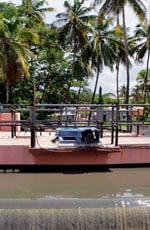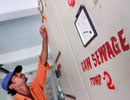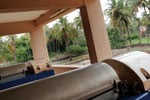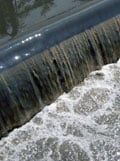Clean effluent
Experts from government, professional and academic organizations in India are flocking to the sewage treatment plant at Panjim, Goa, where the latest sludge treatment technology is being used with excellent results.
DATE 2023-11-28 AUTHOR R.F. Mamoowala Sewage and industrial effluent treatment is attracting increasing attention from public authorities and governments in India. Many municipal corporations in the country have recently invested in sewage treatment plants and many more are under construction. SFC Environmental Technologies, a joint venture between SFC, Austria (that holds worldwide patents for cyclic activated sludge technology, C-Tech, and membrane bioreactor technology,) and Enviropro Water Tech, Mumbai, has a prominent position in this industry.
Sewage and industrial effluent treatment is attracting increasing attention from public authorities and governments in India. Many municipal corporations in the country have recently invested in sewage treatment plants and many more are under construction. SFC Environmental Technologies, a joint venture between SFC, Austria (that holds worldwide patents for cyclic activated sludge technology, C-Tech, and membrane bioreactor technology,) and Enviropro Water Tech, Mumbai, has a prominent position in this industry.
The company mainly provides services such as engineering and project management consultancy in addition to supplying C-Tech components. It supports major sewage treatment companies and contractors through the entire project from concept to commissioning.
Sandeep Asolkar, Managing Director of SFC, met us at the clean and green sewage water treatment plant that he has constructed for the Public Works Department (PWD) of the Goa Government in Panjim, Western India. He oozes the confidence of somebody who has successfully introduced a new technology in environmental engineering.
 Asolkar says waste-water laws were enacted in India in 1976, but for 20 years only “cosmetic changes” have been made due to lack of money and understanding of modern technology in sewage treatment processes. But in Goa, with an educated population and awareness of environmental issues, SFC got a break in 2003 when Manohar Parrikar, a qualified engineer and the then Goa Chief Minister, approved the 12.5 million litres a day sewage treatment plant using SFC’s CTech technology.
Asolkar says waste-water laws were enacted in India in 1976, but for 20 years only “cosmetic changes” have been made due to lack of money and understanding of modern technology in sewage treatment processes. But in Goa, with an educated population and awareness of environmental issues, SFC got a break in 2003 when Manohar Parrikar, a qualified engineer and the then Goa Chief Minister, approved the 12.5 million litres a day sewage treatment plant using SFC’s CTech technology.
During tender discussions the poor functioning of many conventional sewage treatment plants came up. “They wanted a plant that works and reduces pollution,” says Alsolkar. “The Chief Minister understood technology and directed his officials to study the working of similar SFC installations in Germany and Austria.”
The plant was installed in 2005 and has been working smoothly. The 12.5 million litre a day plant, which normally handles 7–8 million litres, can handle up to 20 million litres, a boon in a region where intense monsoon activity can cause floods.
Outstanding results
When explaining C-Tech, Asolkar says it is an advanced wastewater treatment technology based on activated sludge process. “The treated effluent out of C-Tech is 6 times better than any conventional treatment and there is 50 per cent reduction in power consumption. This produced 6-fold better outlet characteristics. Also, it uses much less land than other conventional technologies, thereby saving high investment costs. The plant is fully computerized and doesn’t require much manual support.”
This technology drastically reduces the BOD (biological oxygen demand) in the treated water from 200–300 ppm to less than 5 ppm. BOD is a measure of the pollution level in water. The COD (chemical oxygen demand) goes down from 450– 600 ppm to less than 20 ppm with this technology. (Both are measures of the relative oxygen-depletion effect of a waste contaminant, and are accepted pollution effect measures.)
SFC holds a massive market share of over 90 per cent in cyclic activated processes in India, says Asolkar. “Our growth has been phenomenal; right now we’re doing 27 plants, 30–40 more are in the pipeline, and by year-end 12 plants will be commissioned.”
These include projects for municipalities in several States, private industries and public sector refineries such as Hindustan Petroleum Corporation. Discussions are in progress with Reliance Industries for a plant at its Special Economic Zone in Navi Mumbai. “Rather than taking on more projects which would push up our turnover a hundred fold, we want to focus on our core strength of technology, service and solutions. When there’s a problem, we’re able to provide service and solutions within 24 hours,” says Asolkar.
New technology, new opportunities
He explains that the dewatering of sludge is a critical step which influences the whole process. Earlier there was not so much focus on solid waste handling, so equipment for this application such as centrifuges were under-engineered and created huge problems at the plant.
In selecting this critical component, Asolkar says, “Since we decided to go for the best in the market, i.e. the Alfa Laval decanter centrifuges, we’ve had no problems with this part.” He also recommends these centrifuges to other contractors, where his company is the consultant. “In our projects at Navi Mumbai and Pune, we’re using the Alfa Laval decanters. They are in line with our philosophy of delivering quality products all the way that guarantees that our plants work smoothly. All the links in the chain are dependent on each other. If a centrifuge didn’t work properly, it would influence the image of the C-Tech as well!”
Sandeep Srivatsava, Manager of Energy and Environment at Alfa Laval India, values Asolkar’s appreciation, and sees huge business opportunities in India in sewage treatment in coming years. “In 2006, the Indian economy grew by some 9 per cent. As development takes place and living standards improve, environmental norms and safeguards will have to be in tune with international norms. In the next three years INR 70,000 million (USD 17.5 million) will be spent in this area and in eight states – Tamil Nadu, Uttar Pradesh, Maharashtra, etc. Many waste water treatment plants are currently being constructed.”
 The Goa plant has become a real showpiece. Officials and ministers, including those from the Indian government’s Environment and Forests Ministry, the Planning Commission, the National River Conservation Directorate, professors from the Indian Institutes of Technology and various State governments have examined this plant and are thrilled with the quality of the outlet water and in favour of the technology applied in the plant. What also helps is a large Central government grant (Jawaharlal Nehru Urban Renewal Mission) to municipalities for their water supply projects. “But the condition is that they won’t qualify for the grant until they treat the sewage properly”, says Asolkar.
The Goa plant has become a real showpiece. Officials and ministers, including those from the Indian government’s Environment and Forests Ministry, the Planning Commission, the National River Conservation Directorate, professors from the Indian Institutes of Technology and various State governments have examined this plant and are thrilled with the quality of the outlet water and in favour of the technology applied in the plant. What also helps is a large Central government grant (Jawaharlal Nehru Urban Renewal Mission) to municipalities for their water supply projects. “But the condition is that they won’t qualify for the grant until they treat the sewage properly”, says Asolkar.
Increased environmental awareness
As States like Tamil Nadu are planning several sewage treatment plants in various municipalities, Asolkar says he has positive experience with Indian politicians and government officials. “I find a change in attitude; they’re willing to go for the best technology.”
Explaining the technology’s environmental benefits, and the vital role of the decanter centrifuges, he says a proper disposal of the sludge is important. “We convert the pollutants in sewage from liquid to solid waste, dewater it and dispose of it. At the Goa plant, the dewatered product is sold as manure. K.R. Shettye, the PWD Engineer in charge of the plant says, “It is a good soil conditioner and fertilizer and we sell it to horticulturists and the forestry department.”
 There is no odour whatsoever from the plant. Shettye points to concrete evidence - a housing project being constructed near the plant where expensive apartments are selling like hot cakes. “Nobody likes to live in an area that smells, but there is no smell because the process is fully aerobic.” In order to further improve the living environment, his senior colleague at PWD Goa, Tulsidas Shirodker, has plans to construct a garden at the premises and to adorn the outlet tanks from where treated water is discharged into the river with blue tiles “so the whole thing will look like a swimming pool.”
There is no odour whatsoever from the plant. Shettye points to concrete evidence - a housing project being constructed near the plant where expensive apartments are selling like hot cakes. “Nobody likes to live in an area that smells, but there is no smell because the process is fully aerobic.” In order to further improve the living environment, his senior colleague at PWD Goa, Tulsidas Shirodker, has plans to construct a garden at the premises and to adorn the outlet tanks from where treated water is discharged into the river with blue tiles “so the whole thing will look like a swimming pool.”
More important than the scenic beauty, feels Asolkar, is the quality water such plants generate. “For me it is both business and a social service. By recycling a depleting resource like water and making it fit for farming, gardening or industrial use, you save a precious national resource.” In Pune, 500 million litres a day of treated sewage water will be pumped to the nearby Baramati agricultural area.
Another crucial saving is on land; he relates the story of a municipality which planned to construct a huge oxidation pond over 79 acres for a 37 million litres a day plant. “What a terrible waste of land. Here we’ve used only 4000 square metres! If the municipality in question were to use C-Tech, it would need only 1 hectare of land; the remaining 78 could be used for agriculture.”
SFC’s goal is to become a global leader. “India is an important market in this respect. In the last two years, half of the plants constructed by the group are located in India. And yet, only 5–10% of the sewage in India is treated today, so this is still a virgin market,” adds Asolkar.
Savings in time, space and energy
“I have known Alfa Laval and its products for 15 years,” says Sandeep Asolkar, Managing Director of SFC Environmental Technologies.
“Earlier their products were considered expensive for the Indian market. But with more funds, changing attitudes and preference for quality products and technology we have now standardized on Alfa Laval centrifuges both in the sewage treatment plants we construct ourselves and in those for which we act as consultants.”
After the Panjim Public Works Department plant, he has four more orders from the Goan government; one for treating hospital waste and recycling the water for air conditioning. Alfa Laval’s decanter centrifuges will be used in all the projects. Sandeep Srivatsava, Energy and Environment Manager at Alfa Laval, says the decanters can handle very high-density solids, whether from municipal or industrial sludge, very efficiently and on a continuous basis.
“Even though the centrifuge is quite a small part of a sewage plant, it is of critical importance that it functions smoothly,” says Asolkar. “The Alfa Laval decanters have worked very well. Except for the installation period, when we always received immediate help when needed, we’ve had no problems with the equipment at all.”
For Srivatsava, Asolkar is a “very important client, who not only places direct orders with us but also recommends us to their end customers. We work closely together.”
Apart from their dependable performance, the decanters cut down on power consumption. “They separate solids from liquids very efficiently,” adds Asolkar. “Conventional methods require much more time, space and energy, so we have gained both in speed and separation efficiency.”
With increasing awareness of environmental and health safety norms in India, he sees considerable business potential. “Now customers have started accepting Alfa Laval’s decanter centrifuges as standard equipment. It’s matter of attitude. Today Indians are going for quality.”
